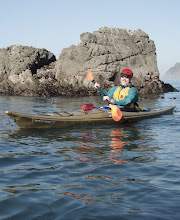- Trim strip to approximate length
- Use a block plane to put a rolling bevel on the strip being installed. This simply means beveling the edge of the strip so that it meets the edge of the previous strip flat. The angle of the bevel depends on the curvature of the side of the boat. This, of course, changes along the strip depending where on the boat the edge of the strip is.
- Cut the end of the strip to the approximate sharp angle it needs to meet the strip on the opposite side correctly.
- Use a block plane to trim the ends of the two corresponding strips so they meet properly at the ends.
- Apply a bead of glue to the edge of the strip already on the kayak.
- Place the strip into place, stapling it to the forms and tightly taping it to the previous strip.
 This photo shows the hull stripped just past the chine (the transition from bottom of the boat to the side). The guillemot has a fairly hard chine. Some builders have recommended stripping this portion of the hull using narrower strips to spread the transition at the tight curve. I opted not to do this and it turned out o.k., but if I were to do it again, I would use thinner strips in this area to make fitting the curve easier.
This photo shows the hull stripped just past the chine (the transition from bottom of the boat to the side). The guillemot has a fairly hard chine. Some builders have recommended stripping this portion of the hull using narrower strips to spread the transition at the tight curve. I opted not to do this and it turned out o.k., but if I were to do it again, I would use thinner strips in this area to make fitting the curve easier. On a couple of the forms at the chine, the strips rose above the form a little. At first I thought that the strips were just following a smooth spline curve and that if I altered the forms by adding a spacer, it would make for a smoother transition at the chine. After a bit of fitting, I discovered that adding the spacer was going to allow the strips to align farther and farther from the form. So, ultimately, I removed the spacers and clamped the strips down to the forms where they were rising up. After a day or two, the strips conformed to the forms with just a staple.
On a couple of the forms at the chine, the strips rose above the form a little. At first I thought that the strips were just following a smooth spline curve and that if I altered the forms by adding a spacer, it would make for a smoother transition at the chine. After a bit of fitting, I discovered that adding the spacer was going to allow the strips to align farther and farther from the form. So, ultimately, I removed the spacers and clamped the strips down to the forms where they were rising up. After a day or two, the strips conformed to the forms with just a staple. The stern close to where the internal stem ends. This is not a good picture, but if you look close and use your imagination, you can see how the ends of the strips are trimmed in order to meet where they come together.
The stern close to where the internal stem ends. This is not a good picture, but if you look close and use your imagination, you can see how the ends of the strips are trimmed in order to meet where they come together. Looking from the center to the bow as stripping continues. It was about this point in the work when I thought, "I can do this!" You can see a little bit of the concave curve at the bow. Getting that curve correct required some steaming and clamping. Some other builders have failed to get that curve well-defined and attribute difficulty in tracking to the lack of that narrowing at the bow and stern.
Looking from the center to the bow as stripping continues. It was about this point in the work when I thought, "I can do this!" You can see a little bit of the concave curve at the bow. Getting that curve correct required some steaming and clamping. Some other builders have failed to get that curve well-defined and attribute difficulty in tracking to the lack of that narrowing at the bow and stern. Stripping continues. I staple each strip to the forms and use masking tape between the forms to hold the strips tightly together while the glue dries.
Stripping continues. I staple each strip to the forms and use masking tape between the forms to hold the strips tightly together while the glue dries. Time for the last strips in the hull. Getting them trimmed to fit took a lot of planing and fitting and planing and fitting, but that is the nature of the beast.
Time for the last strips in the hull. Getting them trimmed to fit took a lot of planing and fitting and planing and fitting, but that is the nature of the beast.Next time: mistakes I made on the hull and how I fixed them.



No comments:
Post a Comment